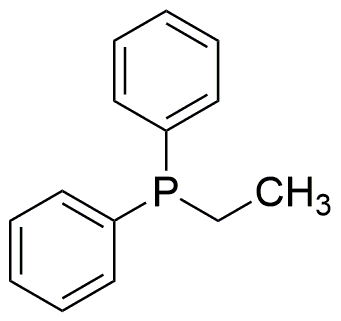Ethyldiphenylphosphine is widely utilized in research focused on:
- Catalysis: This compound serves as a ligand in various catalytic processes, enhancing the efficiency of reactions in organic synthesis, particularly in the production of fine chemicals and pharmaceuticals.
- Organometallic Chemistry: It is used to stabilize metal complexes, which are crucial in developing new materials and catalysts, thus playing a significant role in materials science.
- Pharmaceutical Development: Ethyldiphenylphosphine is involved in the synthesis of biologically active compounds, aiding researchers in drug discovery and development.
- Analytical Chemistry: This chemical can be utilized as a reagent in analytical methods, helping to detect and quantify various substances in complex mixtures.
- Polymer Chemistry: It is applied in the modification of polymers, enhancing their properties for specific applications in industries such as packaging and electronics.
General Information
Properties
Safety and Regulations
Applications
Ethyldiphenylphosphine is widely utilized in research focused on:
- Catalysis: This compound serves as a ligand in various catalytic processes, enhancing the efficiency of reactions in organic synthesis, particularly in the production of fine chemicals and pharmaceuticals.
- Organometallic Chemistry: It is used to stabilize metal complexes, which are crucial in developing new materials and catalysts, thus playing a significant role in materials science.
- Pharmaceutical Development: Ethyldiphenylphosphine is involved in the synthesis of biologically active compounds, aiding researchers in drug discovery and development.
- Analytical Chemistry: This chemical can be utilized as a reagent in analytical methods, helping to detect and quantify various substances in complex mixtures.
- Polymer Chemistry: It is applied in the modification of polymers, enhancing their properties for specific applications in industries such as packaging and electronics.
Documents
Safety Data Sheets (SDS)
The SDS provides comprehensive safety information on handling, storage, and disposal of the product.
Product Specification (PS)
The PS provides a comprehensive breakdown of the product’s properties, including chemical composition, physical state, purity, and storage requirements. It also details acceptable quality ranges and the product's intended applications.
Certificates of Analysis (COA)
Search for Certificates of Analysis (COA) by entering the products Lot Number. Lot and Batch Numbers can be found on a product’s label following the words ‘Lot’ or ‘Batch’.
*Catalog Number
*Lot Number
Certificates Of Origin (COO)
This COO confirms the country where the product was manufactured, and also details the materials and components used in it and whether it is derived from natural, synthetic, or other specific sources. This certificate may be required for customs, trade, and regulatory compliance.
*Catalog Number
*Lot Number
Safety Data Sheets (SDS)
The SDS provides comprehensive safety information on handling, storage, and disposal of the product.
DownloadProduct Specification (PS)
The PS provides a comprehensive breakdown of the product’s properties, including chemical composition, physical state, purity, and storage requirements. It also details acceptable quality ranges and the product's intended applications.
DownloadCertificates of Analysis (COA)
Search for Certificates of Analysis (COA) by entering the products Lot Number. Lot and Batch Numbers can be found on a product’s label following the words ‘Lot’ or ‘Batch’.
*Catalog Number
*Lot Number
Certificates Of Origin (COO)
This COO confirms the country where the product was manufactured, and also details the materials and components used in it and whether it is derived from natural, synthetic, or other specific sources. This certificate may be required for customs, trade, and regulatory compliance.


